This pork butt roast cooks low and slow, resulting in a tender meat that’s perfect for tacos, sandwiches, and more. It’s low fuss but yields high quality flavor!
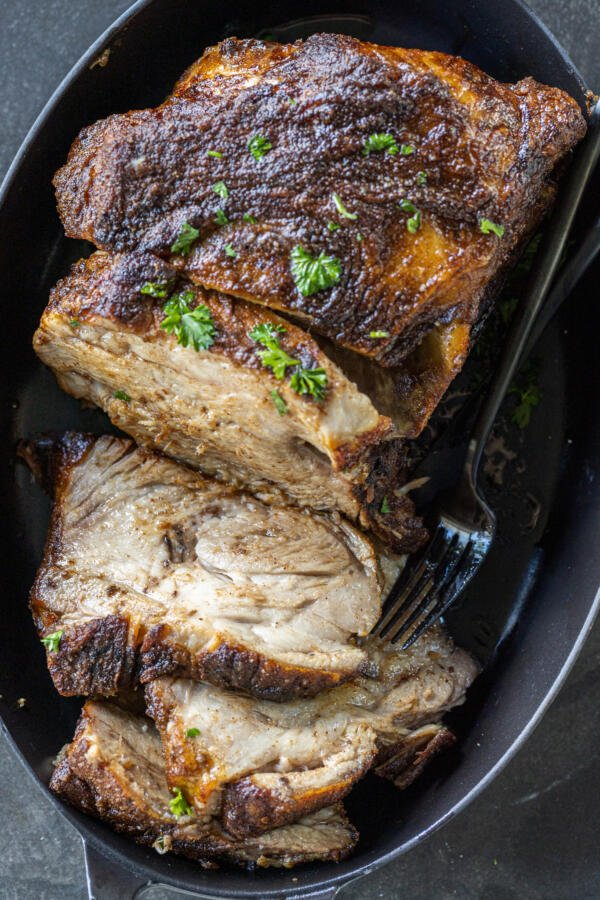
What is Pork Butt Roast?
Pork butt roast is a slow-roasted meat made from the butt cut off a pig’s shoulder. The pork butt is rubbed with a dry spice rub consisting of four spice staples, then roasted for about 5–6 hours until the meat becomes ultra tender. The first 30 minutes of high-heat roasting crisp up the exterior, while the remaining few hours on low heat cook the inside slowly and steadily. The flavor is savory and rich, and when shredded, the tender pork is perfect for meal prepping for multiple meals throughout the week. If you love savory and hearty roasts like this one, try this easy dutch oven pot roast!
Pork Butt vs Pork Shoulder vs Pork Tenderloin
Pork butt, shoulder, and tenderloin often get mixed up with each other. We’ve broken down the differences to make it clear for you.
- Pork butt: Also known as “boston butt”, this cut comes from the thicker section of the shoulder of the pig. It has a large amount of connective tissue and a high fat content, making it the best cut for stewing, braising, and making pulled pork.
- Pork shoulder: Pork shoulder, also known as “picnic shoulder”, also comes from the shoulder section, but has a higher muscle content. Due to less fat marbling, pork shoulder is not as tender and juicy. If you have pork shoulder on hand, follow this recipe.
- Pork tenderloin: Pork tenderloin, or pork loin, is the leanest cut. It is usually a long, cylindrical meat cut from the pig’s back. It has very little fat, so it is not ideal for pulled pork.
Did you know? The pork butt cut is actually located nowhere near the rear of the pig. It is called the “butt” because in colonial times, butchers packed cheap cuts of meat into barrels called “butts” for storage.
How to Make Pork Roast
Pork butt roast is the perfect set-and-forget recipe. It takes only 10 minutes of prep time, leaving you plenty of time to cross everything off your to-do list in the meantime.
- Preheat the oven: Preheat the oven to 450°F while combining all the dry spice ingredients in a small bowl.
- Rub the pork: Rub the pork butt on all sides with the spice rub.
- Bake: Place pork butt with fat side up into a sheet pan or roasting pan (with the wire rack removed). Bake for about 30 minutes.
- Decrease the temperature: Lower the temperature to 250°F and bake an additional five hours, or until the meat reaches 180°F. Remove from the oven, rest for 20 minutes, then enjoy.
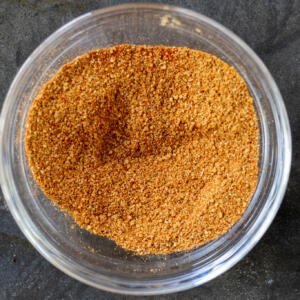
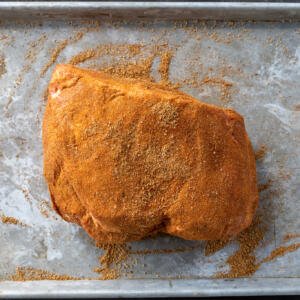
Tips from the Kitchen
Follow these tips and tricks and your pork butt roast will certainly live up to its name as the best pork roast!
- Buy bone-in pork butt: Bone-in pork butt tends to have a stronger, better flavor; however, boneless works well too. Keep in mind boneless pork butt will cook quicker than bone-in.
- Save the juices: Save the juices from the roast to use as needed for extra flavorful moisture.
- Shred before serving: Shredding mixes the crispy pork exterior with the juices inside. This balances the flavor and combines the crispy and tender pieces.
- Marinade overnight (optional): For a stronger flavor, marinade the pork in the dry spice rub overnight. Keep the pork refrigerated while marinating.
- Adjust the spices: Adjust the amount of spices to your liking. Depending on the size of the pork butt, you may require less/more of a dry rub. For additional flavor variety, add onion powder and garlic powder to the spice mixture.
- Rest the meat: Before shredding, rest the meat after removing it from the oven. This allows the juices to stay inside the meat rather than spilling out right away. For extra-juicy meat, rest the meat covered for 30 minutes.
- Use a meat thermometer: To ensure the meat is fully cooked and tender, use a meat thermometer to ensure the temperature is at 180°F.
Recipe Variations
The pork butt roast is incredibly tender and juicy as is; however, adding these steps will send the juices and tenderness over the moon.
- Add a liquid: Adding a half a cup of liquid like chicken broth, beef broth, water, or apple cider makes the roast even more tender. In our experience, this usually isn’t necessary for this recipe unless you prefer significantly tender and juicy meat.
- Cover with a lid: If you choose to use a pot or pan with a lid, experiment with covering it with a lid. Cover only after the pork has had a chance to brown at the high initial heat. The lid will keep more moisture and steam locked inside the pan, resulting in a more tender pork butt.
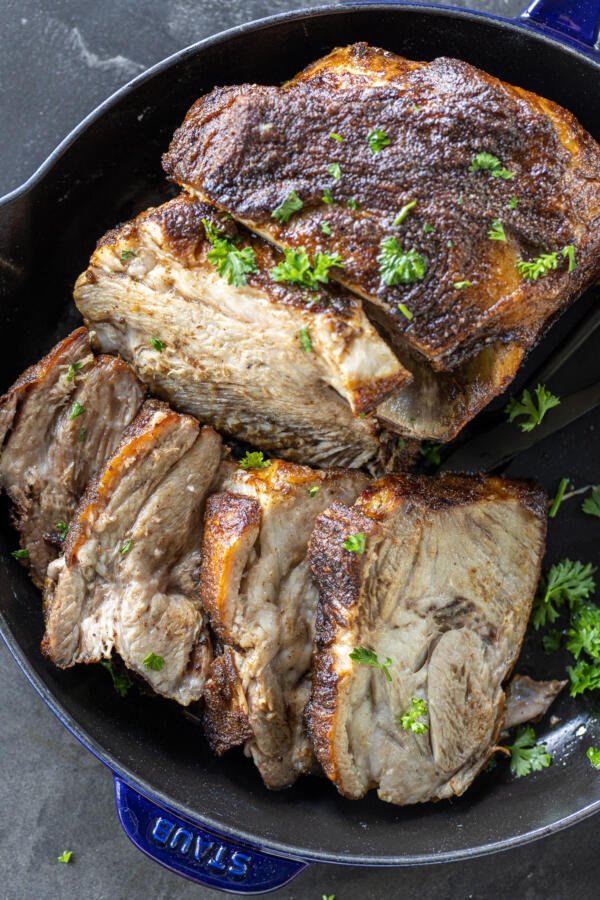
Ways to Serve Pork Roast
Shred the pork roast and serve it alongside a plethora of side dishes or use it to make a new meal by itself. You won’t have leftovers for long!
- Side dish: Pair the pork butt roast with your favorite side dishes like mac and cheese, creamed potatoes, and tomato mozzarella salad with lettuce.
- Sandwich: For a BBQ meal, make pulled pork BBQ sandwiches with BBQ sauce and a side of coleslaw. Or, skip the BBQ and place shredded pork between brioche buns.
- Taco: Instead of ground beef, use pulled pork in this taco recipe. Additionally, serve with homemade tortillas, shredded lettuce, diced tomatoes, pico de gallo, sour cream, cheese, and avocado.
- Quesadilla: Swap out the chicken with pork in this easy chicken quesadilla recipe.
- Burrito: Add more protein to your breakfast by adding pulled pork to breakfast burritos.
- Soup: Use up any leftover pork roast by adding extra meat to your favorite soups including white bean soup and split pea and lentil soup.
Storage Tips + Reheating
Pork butt roast is so easy to make that it’s definitely worthwhile making a large batch. With a container of leftovers, you’ll have protein on hand for a quick meal.
- Refrigerator: To store leftovers for up to five days, let the roasted pork cool completely, then transfer to an airtight container and store in the refrigerator.
- Freezer: To store for up to six months, transfer cooled pork to an airtight container or freezer bags.
- Reheating: For best results, reheat pork in an oven warmed to 250ºF. For a quick, single-serving reheat, heat pork in the microwave. To add more crisp to the pork as it warms, heat shredded pork on a nonstick pan over medium-high heat.
Hot tip: Keep a small bowl of leftover juice from the pan to rehydrate the meat (when desired).
FAQ
Do I need to sear pork butt before roasting?
It is not necessary to sear or brown the pork before roasting. The initial thirty minutes of roasting at a high heat makes the outer layer of the pork crispy, locking the juices inside.
Is it possible to overcook pork butt?
It is hard to overcook pork butt; however, it is best not to cook for too long beyond doneness or the pork may become too tender.
Can I cook pork butt roast in a slow cooker?
Pork butt roast can be cooked in an instant pot, slow cooker, or in the oven. This recipe is for oven-roasted pork butt roast as most cooks and kitchens are certain to have an oven.
More Pork Recipes
- Pork Kabobs – The staple of a family BBQ
- Grilled Pork Tenderloin – There’s no dry pork loin here!
- Roasted Pork Shoulder – Pulled pork made from the shoulder cut
- Oven Baked BBQ Pork Ribs – Fall off the bone tender and finger-lickin’ good
Recipe
Ingredients
- 6 lb pork butt
- 2 tbsp kosher salt
- 1 tbsp ground black pepper
- 1 tbsp paprika
- 1 tbsp ground cumin
Instructions
- Preheat oven to 450°F. Combine all the spices together in a bowl.
- Rub the pork butt on all sides with the spice rub. Place the pork butt with the fat side up onto a baking sheet. Bake uncovered for about 30 minutes.
- Lower the temperature to 250°F, and bake for five more hours, or until the center of the meat reaches 180°F. Remove pork from the oven, let it rest for ~20 minutes, and enjoy.
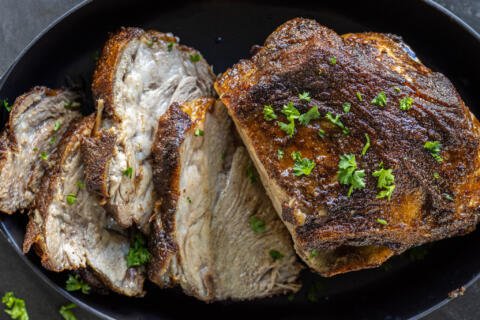
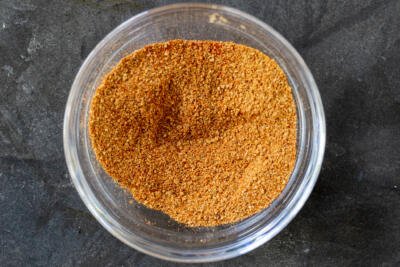
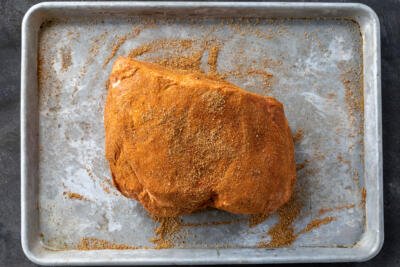
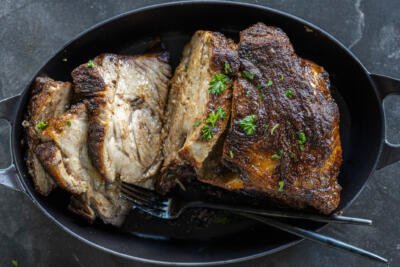
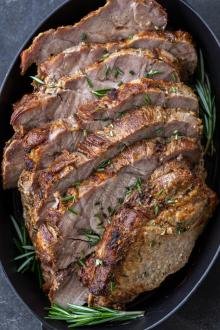
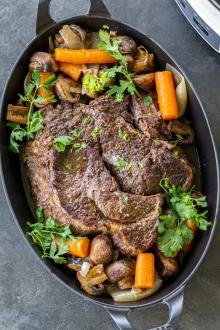

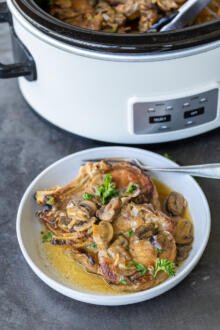
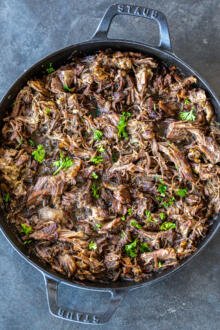
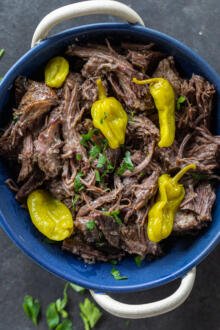
I made this recipe for a 3lb pork butt roast. Just halved the ingredients. I baked it at 450 for 30 minutes uncovered and finished the meat covered and baked 2 1/2hr at 250 degrees. We loved the results. So tender and a great crust. Thank you
Hey Ruth, Sounds like it turned out perfect! Enjoy!
To clarify, the whole time it’s being baked uncovered?
Hi Nelya, It can be baked uncovered, or after its been browned and cook on high heat, feel free to cover with for extra moist meat.